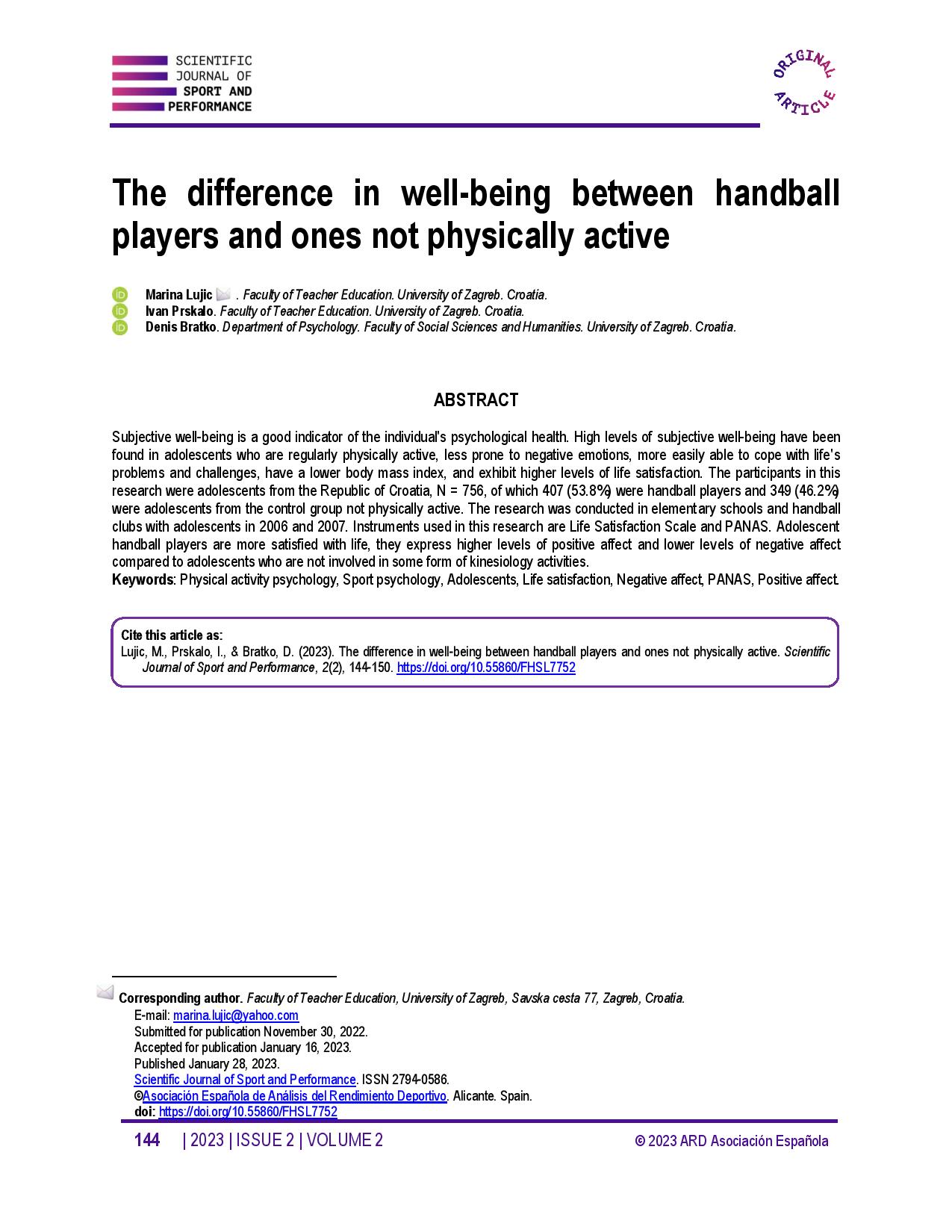The difference in well-being between handball players and ones not physically active
Main Article Content
Abstract
Subjective well-being is a good indicator of the individual's psychological health. High levels of subjective well-being have been found in adolescents who are regularly physically active, less prone to negative emotions, more easily able to cope with life's problems and challenges, have a lower body mass index, and exhibit higher levels of life satisfaction. The participants in this research were adolescents from the Republic of Croatia, N = 756, of which 407 (53.8%) were handball players and 349 (46.2%) were adolescents from the control group not physically active. The research was conducted in elementary schools and handball clubs with adolescents in 2006 and 2007. Instruments used in this research are Life Satisfaction Scale and PANAS. Adolescent handball players are more satisfied with life, they express higher levels of positive affect and lower levels of negative affect compared to adolescents who are not involved in some form of kinesiology activities.
Article Details

This work is licensed under a Creative Commons Attribution-NonCommercial-ShareAlike 4.0 International License.
References
Brown, J., MacDonald, R., & Mitchell, R. (2015). Are people who participate in cultural activities more satisfied with life? Social Indicators Research, 135-146. https://doi.org/10.1007/s11205-014-0678-7 DOI: https://doi.org/10.1007/s11205-014-0678-7
Chmelik, F., Frömel , K., Groffik, D., Šafář , M., & Mitáš, J. (2021). Does Vigorous Physical Activity Contribute to Adolescent Life Satisfaction? International Journal of Environmental Research and Public Health, 18(5), 2236. https://doi.org/10.3390/ijerph18052236 DOI: https://doi.org/10.3390/ijerph18052236
Costigan, S., Lubans, D., Lonsdale, C., Sanders, T., & Del Pozo Cruz, B. (2019). Associations between physical activity intensity and well-being in adolescents. Preventive Medicine, 55-61. https://doi.org/10.1016/j.ypmed.2019.05.009 DOI: https://doi.org/10.1016/j.ypmed.2019.05.009
Diener, E., Oishi, S., & Lucas, R. (2003). Personality, culture and subjective well-being: Emotional and Cognitive Evaluations of Life. Annual Review of Psychology, 54, 403-425. https://doi.org/10.1146/annurev.psych.54.101601.145056 DOI: https://doi.org/10.1146/annurev.psych.54.101601.145056
Diener, E., Pressman, S., Hunter, J., & Delgadillo-Chase, D. (2017). If, Why, and When Subjective Well‐Being Influences Health, and Future Needed Research. Applied Psychology: Health and Well-Being, 2, 133-167. https://doi.org/10.1111/aphw.12090 DOI: https://doi.org/10.1111/aphw.12090
Groffik, D., Mitáš, J., jakubec, L., Svozil, Z., & Frömel, K. (2020). Adolescents' physical activity in education systems varies in the number of weekly physical education lessons. Research Quarterly for Exercise and Sport, 91, 551-561. https://doi.org/10.1080/02701367.2019.1688754 DOI: https://doi.org/10.1080/02701367.2019.1688754
Guddal Hjelle, M., Øien Stensland, S., Cvancarova Småstuen, M., Bakke Johnsen, M., Zwart, J., & Storheim, K. (2019). Physical activity and sport participation among adolescents: associations with mental health in different age groups. Results from the Young- HUNT study: a cross-sectional survey. BMJ Open, 1-10. https://doi.org/10.1136/bmjopen-2018-028555 DOI: https://doi.org/10.1136/bmjopen-2018-028555
Hung Chen, L. (2013). Gratitude and Adolescent Athletes' Well-Being: The Multiple Mediating Roles of Perceived Social Support from Coaches and Teammates. Social Indicators Research, 273-285. https://doi.org/10.1007/s11205-012-0145-2 DOI: https://doi.org/10.1007/s11205-012-0145-2
Križanić, V. (2013). Temperament i odnos pozitivnih i negativnih temeljnih afekata u kontekstu dinamičkog modela afekta. Neobjavljena doktorska disertacija. Zagreb: Filozofski fakultet Sveučilišta u Zagrebu.
Morgan, P., Young, M., Smith, J., & Lubans, D. (2016). Targeted health behavior interventions promoting physical activity: a conceptual model. Exercise and Sport Sciences Reviews, 44(2), 71-80. https://doi.org/10.1249/JES.0000000000000075 DOI: https://doi.org/10.1249/JES.0000000000000075
Penezić, Z. (1996). Zadovoljstvo životom-provjera konstrukta. Zadar: Filozofski fakultet u Zadru.
Penezić, Z. (2006). Zadovoljstvo životom u adolescentnoj i odrasloj dobi. Društvena istraživanja, 4-5(84-85), 643-669.
Reigal Garrido, R., Videra, A., & Gil, J. (2014). Physical exercise, general self-efficacy and life satisfaction in adolescence. Revista Internacional de Medicina y Ciencias de la Actividad Fisica y del Deporte, 14(55), 5611-576.
Smedegaard, S., Christiansen, L., Lund-Cramer, P., Bredahl, T., & Skovgaard, T. (2016). Improving the well-being of children and youths: A randomized multicomponent, school-based, physical activity intervention. BMC Public Health, 16, 1127. https://doi.org/10.1186/s12889-016-3794-2 DOI: https://doi.org/10.1186/s12889-016-3794-2
Watson, D., Clark, L., & Tellegen, A. (1988). Development and validation of brief measures of positive and negative affect: the PANAS scales. Journal of Personality and Social Psychology, 54(6), 1063-1970. https://doi.org/10.1037/0022-3514.54.6.1063 DOI: https://doi.org/10.1037/0022-3514.54.6.1063




